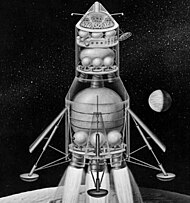Direct ascent
This article relies largely or entirely on a single source. (October 2015) |

Direct ascent was a method for performing a manned landing on the Moon proposed in the United States for the Apollo program.[1] It would have required developing an enormous launch vehicle, either the Saturn C-8 or Nova rocket, to launch the three-man Apollo spacecraft, with an attached landing module, directly to the Moon, where it would land tail-first and then launch off the Moon for the return to Earth. The other two options that NASA considered required a somewhat smaller launch vehicle, either the Saturn C-4 or C-5. These were Earth Orbit Rendezvous, which would have involved at least two launches to assemble the direct-landing and return vehicle in orbit; and Lunar Orbit Rendezvous (LOR), which carried a smaller two-man lunar lander spacecraft for flight between lunar orbit and the surface. LOR was the strategy used successfully in Apollo.[1]
The Soviet Union also considered several direct ascent strategies, though in the end they settled on an approach similar to NASA's: two men in a Soyuz spacecraft with a one-man LK lander. The failure of the Soviets' N1 rocket delayed their lunar program substantially, however, and they were nowhere close to a successful N1 launch when Apollo 11 lifted off and made the first lunar landing. The Soviets had planned to use an LK, which looked much like a smaller version of the spider-like Lunar Module, although OKB-52 continued to develop the UR-700 modular booster for the direct ascent LK-700 ship.
Science fiction movies such as Destination Moon had frequently depicted direct ascent missions.
See also
References
- ^ a b "NASA - Lunar Orbit Rendezvous and the Apollo Program". NASA. April 22, 2008.
